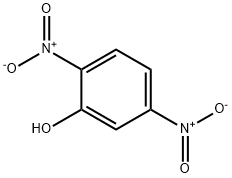2,5-DINITROPHENOL
- CAS No.
- 329-71-5
- Chemical Name:
- 2,5-DINITROPHENOL
- Synonyms
- 2,5-Dnp;Nsc 90441;γ-Dinitrophenol;p-Dinitrophenol;2,5-Dinitrofenol;2,5-dinitro-pheno;2,5-DINITROPHENOL;PARA-DINITROPHENOL;gamma-dinitro-pheno;GAMMA-DINITROPHENOL
- CBNumber:
- CB6389758
- Molecular Formula:
- C6H4N2O5
- Molecular Weight:
- 184.11
- MDL Number:
- MFCD00007108
- MOL File:
- 329-71-5.mol
| Melting point | 103-106 °C(lit.) |
|---|---|
| Boiling point | 318.03°C (rough estimate) |
| Density | 1.7195 (rough estimate) |
| refractive index | 1.4738 (estimate) |
| solubility | Solubility Sparingly soluble in water; soluble in ethanol, ether |
| pka | 5.21, 5.1, 5.0(at 25℃) |
| form | Solid |
| color | Yellowish needles |
| PH Range | 4(colourless)-5.8(yellow) |
| Merck | 14,3281 |
| BRN | 1913411 |
| Stability | Light Sensitive |
| Major Application | Liquid crystal films, electrophotographic materials, adhesives, inks, lubricants, preservation of cut flowers, food storage, materials for evaluating dental cariesactivity |
| CAS DataBase Reference | 329-71-5(CAS DataBase Reference) |
| EWG's Food Scores | 1 |
| FDA UNII | HSD25Q268Z |
| EPA Substance Registry System | 2,5-Dinitrophenol (329-71-5) |
SAFETY
Risk and Safety Statements
| Symbol(GHS) |     GHS02,GHS06,GHS08,GHS09 |
|---|---|
| Signal word | Danger |
| Hazard statements | H228-H300+H310+H330-H301-H311-H331-H373-H411 |
| Precautionary statements | P261-P273-P280-P301+P310-P311-P210-P240-P241-P260-P262-P264-P270-P271-P284-P301+P310+P330-P302+P352+P310+P361+P364-P304+P340+P310-P391-P403+P233-P405-P501 |
| Hazard Codes | T,N |
| Risk Statements | 23/24/25-33-51/53 |
| Safety Statements | 28-37-45-61 |
| RIDADR | UN 1320 4.1/PG 1 |
| WGK Germany | 3 |
| RTECS | SL2900000 |
| HazardClass | 4.1 |
| PackingGroup | I |
| HS Code | 29089990 |
| Hazardous Substances Data | 329-71-5(Hazardous Substances Data) |
2,5-DINITROPHENOL Chemical Properties,Uses,Production
Chemical Properties
Yellow needles, flammable. Soluble in ether, benzene, hot water, and ethanol.
Uses
2,5-Dinitrophenol (wetted with ca. 20% Water) (unit weight on dry weight basis) is a useful reagent for the preparation of yttrium nitrophenolate aminebis(benzotriazolylphenolate) complexes.
Definition
ChEBI: 2,5-dinitrophenol is a dinitrophenol having the nitro groups at the 2- and 5-positions.
General Description
Yellow crystalline solid with a sweet musty odor. Sinks and mixes slowly with water.
Air & Water Reactions
Slowly mixes with water.
Reactivity Profile
2,5-DINITROPHENOL can detonate or explode when heated under confinement [USCG, 1999]. Phenols do not behave as organic alcohols, as one might guess from the presence of a hydroxyl (-OH) group in their structure. Instead, they react as weak organic acids. Phenols and cresols are much weaker as acids than common carboxylic acids (phenol has Ka = 1.3 x 10^[-10]). These materials are incompatible with strong reducing substances such as hydrides, nitrides, alkali metals, and sulfides. Flammable gas (H2) is often generated, and the heat of the reaction may ignite the gas. Heat is also generated by the acid-base reaction between phenols and bases.
Health Hazard
INHALATION, INGESTION OR SKIN ABSORPTION: Fatigue, thirst, sweating, flushing of face, nausea, vomiting, abdominal pain, diarrhea; restlessness, anxiety, excitement occasionaly leading to convulsions; fever, tachycardia, labored respiration, cyanosis, and sometimes muscle cramps. Loss of consciousness, cessation of breathing and death. EYES: Causes dilation of pupils or posterior subcapsular opacities or cataracts. SKIN: Discoloration, irritation, and dermatitis.
Purification Methods
Crystallise 2,5-dinitrophenol from H2O with a little EtOH. [Beilstein 6 IV 1383.]
2,5-DINITROPHENOL Preparation Products And Raw materials
329-71-5(2,5-DINITROPHENOL)Related Search:
1of4





